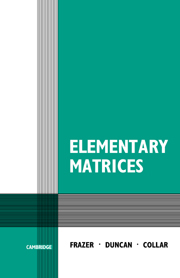Book contents
- Frontmatter
- Contents
- Preface
- CHAPTER I FUNDAMENTAL DEFINITIONS AND ELEMENTARY PROPERTIES
- CHAPTER II POWERS OF MATRICES, SERIES, AND INFINITESIMAL CALCULUS
- CHAPTER III LAMBDA-MATRICES AND CANONICAL FORMS
- CHAPTER IV MISCELLANEOUS NUMERICAL METHODS
- CHAPTER V LINEAR ORDINARY DIFFERENTIAL EQUATIONS WITH CONSTANT COEFFICIENTS
- CHAPTER VI LINEAR ORDINARY DIFFERENTIAL EQUATIONS WITH CONSTANT COEFFICIENTS (continued)
- CHAPTER VII NUMERICAL SOLUTIONS OF LINEAR ORDINARY DIFFERENTIAL EQUATIONS WITH VARIABLE COEFFICIENTS
- CHAPTER VIII KINEMATICS AND DYNAMICS OF SYSTEMS
- CHAPTER IX SYSTEMS WITH LINEAR DYNAMICAL EQUATIONS
- CHAPTER X ITERATIVE NUMERICAL SOLUTIONS OF LINEAR DYNAMICAL PROBLEMS
- CHAPTER XI DYNAMICAL SYSTEMS WITH SOLID FRICTION
- CHAPTER XII ILLUSTRATIVE APPLICATIONS OF FRICTION THEORY TO FLUTTER PROBLEM
- CHAPTER XIII PITCHING OSCILLATIONS OF A FRICTIONALLY CONSTRAINED AEROFOIL
- List of References
- List of Authors Cited
- Index
CHAPTER IX - SYSTEMS WITH LINEAR DYNAMICAL EQUATIONS
Published online by Cambridge University Press: 04 August 2010
- Frontmatter
- Contents
- Preface
- CHAPTER I FUNDAMENTAL DEFINITIONS AND ELEMENTARY PROPERTIES
- CHAPTER II POWERS OF MATRICES, SERIES, AND INFINITESIMAL CALCULUS
- CHAPTER III LAMBDA-MATRICES AND CANONICAL FORMS
- CHAPTER IV MISCELLANEOUS NUMERICAL METHODS
- CHAPTER V LINEAR ORDINARY DIFFERENTIAL EQUATIONS WITH CONSTANT COEFFICIENTS
- CHAPTER VI LINEAR ORDINARY DIFFERENTIAL EQUATIONS WITH CONSTANT COEFFICIENTS (continued)
- CHAPTER VII NUMERICAL SOLUTIONS OF LINEAR ORDINARY DIFFERENTIAL EQUATIONS WITH VARIABLE COEFFICIENTS
- CHAPTER VIII KINEMATICS AND DYNAMICS OF SYSTEMS
- CHAPTER IX SYSTEMS WITH LINEAR DYNAMICAL EQUATIONS
- CHAPTER X ITERATIVE NUMERICAL SOLUTIONS OF LINEAR DYNAMICAL PROBLEMS
- CHAPTER XI DYNAMICAL SYSTEMS WITH SOLID FRICTION
- CHAPTER XII ILLUSTRATIVE APPLICATIONS OF FRICTION THEORY TO FLUTTER PROBLEM
- CHAPTER XIII PITCHING OSCILLATIONS OF A FRICTIONALLY CONSTRAINED AEROFOIL
- List of References
- List of Authors Cited
- Index
Summary
Introductory Remarks. The present Chapter deals with motions governed by linear ordinary differential equations with constant coefficients. The language of the dynamics of material systems will be used throughout, but the treatment can, for instance, be applied equally well to electrical systems. The discussion and exemplification of approximate numerical methods of solution is reserved for Chapter x.
Disturbed Motions. Except with very special systems or types of motion the differential equations which arise in dynamics are non-linear and do not admit exact solution. It is, however, sometimes possible to obtain particular solutions, such as those corresponding to equilibrium or steady motion. Then, if the system is supposed to be slightly disturbed from this known condition, the resulting small motion of deviation will be given by a set of linear differential equations. In the special case where the undisturbed state of the system is one of equilibrium or steady motion, the equations of disturbed motion will have constant coefficients and will be soluble by the methods of Chapters v and vi. In more general cases the equations will have for coefficients given functions of time, and they will thus be of the types considered in Chapter vii.
The disturbances just referred to may be of two kinds. They may be merely temporary, and represented by a set of initial conditions of motion which differ slightly from those corresponding to the undisturbed motion.
- Type
- Chapter
- Information
- Elementary Matrices , pp. 280 - 307Publisher: Cambridge University PressPrint publication year: 1938

